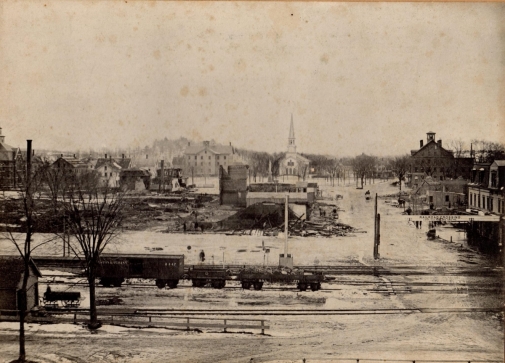how
we got started
In 2012, Natick Center became one of fourteen initial communities to be designated as a Cultural District by the Commonwealth of Massachusetts after over 40 years of concentrated efforts toward economic revitalization and reimagining.
in the beginning
Most of Natick Center was built between 1875 and 1900, a period when Natick reached its peak as a manufacturing and commercial center. The buildings are a legacy from a community that once boasted 22 shoe factories, a dozen commercial greenhouses, a baseball factory, and the businesses and social networks that supported these industries.
Until the 1830s, there was a center to Natick, but no Natick Center as the centers of commerce were to the north (Hartford Street) and the south (Eliot Street). Once Central Street was laid out, and the railroad arrived, the portion of town that once had only 15 houses grew rapidly.
Increased business opportunities attracted several “out of towners” to Natick Center, including Nathaniel Clark (Clark’s Block), Henry Wilson and Edward Walcott (Walcott/Middlesex Block, now known as “the missing tooth” building).

the fire of 1874
Early in the morning of January 13, 1874, a fire broke out in a shoe factory adjacent to Clark’s Block on Main Street. A lack of water and dry conditions combined to turn a minor fire into a major disaster; when the smoke cleared the following morning, 18 blocks were destroyed, including Clark’s Block which housed the town offices, the fire and police stations, the First Congregational Church and many other businesses.
Within days, Natick Center began to build anew.
The Center developed at a time when the population was about 10,000, and 3 out of every 4 residents lived within a mile of downtown – if anything was needed, a resident could either walk or take “the electric road,” an early name for the streetcar.
For decades, the railroad was the quickest way to carry freight and passengers from one point to another. From the 1830s until the early 1890s, the railroad through Natick Center was street level. Because of traffic and safety concerns, the town decided in 1894 to depress the tracks 30 feet for a length of about a half-mile. The project was completed in the fall of 1897. Just above the tracks, where a retail plaza stands today, a depot served residents.
Three of the most architecturally essential buildings were built for fraternal organizations – the Masonic Building, the John Walcott Building (now known as the Debsan Building), both on Main Street, and the International Order of Odd Fellows at the corner of South Main and Pond streets.
At one time, Natick Center businesses included Woolworth’s, Finast Supermarket, A&P Grocery and Gilchrist’s Department Store. With the expansion of Route 9 in the early 1950s, and the development of malls along the “Golden Triangle”, Natick Center began losing these regional and national chain stores to the malls. Local retail shops, along with medical offices and other commercial ventures, would soon move in to occupy these vacant storefronts.

recognized as a cultural district
After over 40 years of concentrated efforts toward economic revitalization, Natick’s quaint downtown has reshaped its identity as the MetroWest region’s hub for arts and culture. In 2012, Natick Center became one of fourteen initial communities to be designated as a Cultural District by the Commonwealth of Massachusetts. The community continues to work together to improve and expand upon the Cultural District’s year-round events calendar and numerous cultural offerings.
Since then, the District has applied for renewal with the Mass Cultural Council to remain a district, and was approved in 2017 and 2022. We look forward to making even further strides in developing the economy and arts and culture scene in Natick Center.
